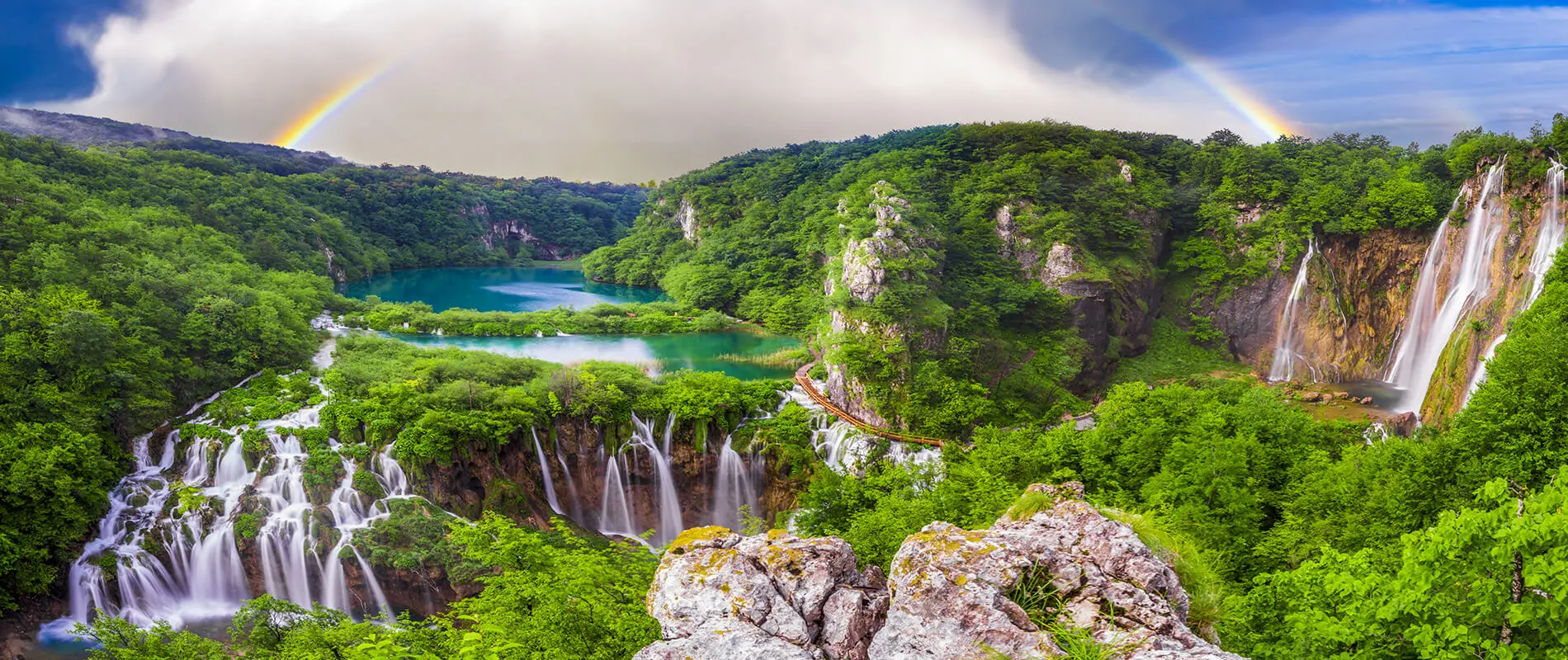Introduction
Plitvice Lakes National Park, located in central Croatia, is a natural wonder that attracts visitors from all over the world. Known for its cascading lakes, stunning waterfalls, and lush greenery, this UNESCO World Heritage site offers an unforgettable experience for nature enthusiasts. Whether you’re planning a day trip or a longer stay, this comprehensive guide will help you make the most of your visit to Plitvice Lakes National Park.
History of Plitvice Lakes National Park
A Brief Overview
Plitvice Lakes National Park was established in 1949 and is the oldest and largest national park in Croatia. It covers an area of nearly 300 square kilometers and is renowned for its 16 terraced lakes, which are interconnected by a series of waterfalls. The park’s unique geology and hydrology have created a diverse ecosystem that supports a wide variety of plant and animal life.
UNESCO World Heritage Site
In 1979, Plitvice Lakes National Park was designated a UNESCO World Heritage site due to its outstanding natural beauty and ecological significance. The park’s pristine condition is carefully maintained to ensure that visitors can enjoy its beauty while preserving its delicate ecosystems.
Planning Your Visit
Best Time to Visit
The best time to visit Plitvice Lakes National Park is during the spring (April to June) and fall (September to October) when the weather is mild, and the park is less crowded. Summer (July to August) is also a popular time to visit, but be prepared for larger crowds and higher temperatures. Winter (November to March) offers a unique experience with frozen waterfalls and snow-covered landscapes, but some trails and facilities may be closed.
How to Get There
Plitvice Lakes National Park is located about halfway between the cities of Zagreb and Zadar, making it easily accessible by car, bus, or organized tour. The park has two main entrances: Entrance 1 (Lower Lakes) and Entrance 2 (Upper Lakes). Both entrances have ample parking, restrooms, and visitor centers.
Entrance Fees and Tickets
Entrance fees vary depending on the season, with higher prices during the peak summer months. Tickets can be purchased online in advance or at the park’s entrances. It’s recommended to buy tickets in advance, especially during the busy summer months, to avoid long lines.
Exploring the Park
Hiking Trails
Plitvice Lakes National Park has several well-marked hiking trails that range from easy to challenging. The trails are designed to showcase the park’s most stunning features, including its lakes, waterfalls, and diverse flora and fauna.
Trail A (2-3 hours)
This is a short loop trail that covers the Lower Lakes and is perfect for a quick visit. It starts and ends at Entrance 1 and includes some of the park’s most iconic waterfalls.
Trail B (3-4 hours)
Trail B is a longer loop that also starts and ends at Entrance 1 but includes a boat ride across Kozjak Lake. This trail offers a more comprehensive tour of the Lower Lakes.
Trail C (4-6 hours)
Starting at Entrance 1, Trail C covers both the Lower and Upper Lakes, offering a full day of exploration. This trail includes boat and train rides within the park.
Trail H (6-8 hours)
Trail H is a loop trail starting at Entrance 2 that covers both the Upper and Lower Lakes. This trail is ideal for those who want to see the entire park in one day.
Boat and Train Rides
The park offers electric boat rides on Kozjak Lake and panoramic train rides that connect different parts of the park. These rides are included in the ticket price and provide a relaxing way to see the park’s highlights.

Waterfalls to See
Veliki Slap (Big Waterfall)
Veliki Slap, also known as the Big Waterfall, is the tallest waterfall in Plitvice Lakes National Park, standing at 78 meters (256 feet). It’s located near Entrance 1 and is a must-see for all visitors.
Galovački Buk
Galovački Buk is a beautiful set of waterfalls that flow into a blue pool. It is in the Upper Lakes. This is one of the park’s most beautiful spots.
Mali Prštavac
Mali Prštavac, or Little Prštavac, is a beautiful waterfall located in the Upper Lakes. It’s less crowded than some of the other waterfalls, making it a great spot for photography.
Wildlife and Nature Observation
Bird Watching
Plitvice Lakes National Park is home to over 160 species of birds, making it a paradise for bird watchers. Bring your binoculars and look out for species such as the great spotted woodpecker, golden eagle, and kingfisher.
Flora and Fauna
The park’s diverse ecosystems support a wide variety of plant and animal life. Keep an eye out for wildflowers, orchids, and rare species such as the brown bear, wolf, and lynx.
Picnicking and Dining
Picnic Areas
There are several designated picnic areas within the park where visitors can relax and enjoy a meal surrounded by nature. These areas are equipped with tables, benches, and trash bins.
On-Site Dining
The park has several restaurants and cafes that offer a variety of meals and snacks. Options range from quick bites to full meals, with many featuring traditional Croatian dishes.
Accommodation
Hotels and Lodges
There are several hotels and lodges located within and near the park, offering a range of accommodations from budget to luxury. Staying overnight allows you to explore the park at a more relaxed pace and experience its beauty during the quieter early morning and evening hours.
Camping
While camping is not allowed within the park itself, there are several campsites located nearby. These campsites offer a more rustic experience and are a great option for nature lovers.
Safety Tips
Stay on Marked Trails
To protect both yourself and the park’s delicate ecosystems, always stay on the designated trails and follow posted signs.
Stay Hydrated
Bring a lot of water, especially when it’s hot outside. Throughout the park, there are places to replace your water bottles.
Weather Awareness
Before you go, check the weather report and be ready for things to change. Wear several layers, and if it rains, bring rain gear.
Emergency Contacts
In case of an emergency, contact park staff or call 112, the emergency number in Croatia. The park is equipped with emergency response systems to ensure visitor safety.
Photography Tips
Best Spots for Photos
- Veliki Slap: Capture stunning views of the Big Waterfall from the observation deck.
- Kozjak Lake: The boat ride across Kozjak Lake offers numerous photo opportunities.
- Upper Lakes: The cascades and pools in the Upper Lakes area are perfect for capturing the park’s natural beauty.
Photo Etiquette
Respect Nature: Avoid disturbing wildlife or damaging plants while taking photos.
Share Respectfully: Tag the park in your social media posts and use official hashtags to share your experience.
Local Culture and Nearby Attractions
Cultural Sites
The region surrounding Plitvice Lakes National Park is rich in cultural heritage. Consider visiting nearby historical sites such as the Rastoke village, known for its charming waterfalls and traditional architecture.
Local Cuisine
Don’t miss the opportunity to sample traditional Croatian dishes at local restaurants. Specialties include lamb, trout, and a variety of homemade cheeses and pastries.
Nearby Attractions
- Rastoke Village: Often referred to as “Little Plitvice,” this picturesque village is known for its waterfalls and traditional watermills.
- Barac Caves: Explore the fascinating underground world of Barac Caves, located just a short drive from the park.
- Zagreb and Zadar: Both cities are within a couple of hours’ drive and offer a wealth of historical and cultural attractions.
Conclusion
A visit to Plitvice Lakes National Park is an unforgettable experience that offers a unique blend of natural beauty and tranquility. With its cascading lakes, lush forests, and diverse wildlife, the park provides countless opportunities for exploration and relaxation. Whether you’re planning a day trip or an extended stay, this comprehensive guide will help you make the most of your visit to this stunning natural wonder.
FAQs
Q1. Can I swim in the lakes at Plitvice Lakes National Park?
No, swimming is not allowed in the lakes to protect the delicate ecosystem and maintain the water quality.
Q2. Are pets allowed in Plitvice Lakes National Park?
Pets are welcome, but they have to be on a lead at all times. Do not forget to clean up after your pet.
Q3. What is the best time of year to visit Plitvice Lakes National Park?
Spring and fall are the best times to go because the weather is nice and there aren't as many people there.
Q4. Are there guided tours available at Plitvice Lakes National Park?
Yes, guided tours are available and can be booked through the park's official website or at the visitor centers.
Q5. How long should I plan to spend at Plitvice Lakes National Park?
A full day is recommended to explore the main trails and attractions, but an overnight stay allows for a more relaxed visit.



